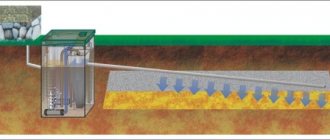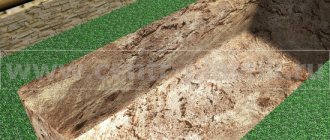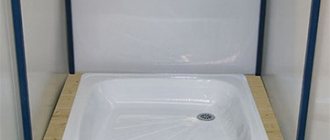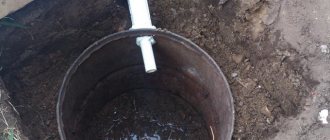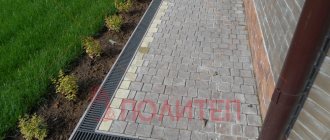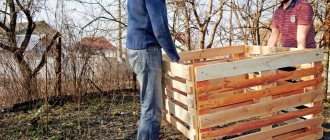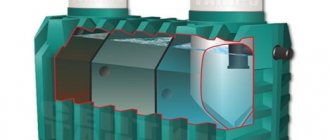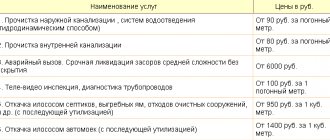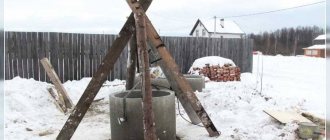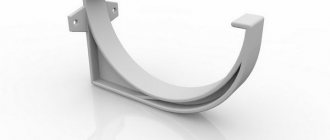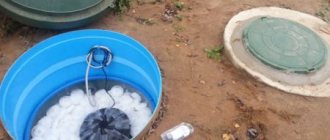Initial conditions
aazinusFORUMHOUSE Member
The house stands on a bolt, the floating foundation is a caisson until it leaks. High water: off-season – 30 cm; in summer - 70 cm, in drought, it went up to 1.5 meters. Five people live in the house, sometimes seven. It had to be done in winter. I refused to pour concrete. In addition, pouring concrete into a swamp requires good pumps for pumping. According to calculations, the volume of discharge is 7×150=1050 liters, in total – cubic meters. Safety factor (cleaning time) – 3.5 days. The volume of the septic tank (more correctly, local treatment station, VOC) is 3-3.5 m³.
After studying the forum, aazinus chose a design scheme with aeration:
- the first cube is a settling tank;
- the second is aerated;
- the third is aerated, but weaker, so that the sludge settles.
Materials and components
Topikstarter purchased Eurocubes cheaply - three pieces for two thousand rubles. Looking ahead, we can note that such a low price is associated with the specifics of the application - the containers were used for chemicals (raw materials for superglue), while food containers are much more expensive. The remaining contents were cleaned and disposed of (washed with gasoline/acetone/solvent on an iron tray, the drain was burned, the coals were packaged and thrown into the trash). In addition to the cubes, for a future installation aazinus bought:
- compressor made in China (3 thousand rubles);
- finely dispersed aeration elements (2 x 800 rubles);
- American load for bacteria (2 thousand rubles) - in fact, just a plastic mesh, but expensive, so I sawed it and made loads from plastic mesh for fences.
The rest of the additions - all that was left from the construction was insulation (EPS), and sewer pipes (110 mm), and other “small things”.
HOW IT WORKS?
A small amount or complete absence of oxygen dissolved in water is a common feature of all underground water supplies. But all these sources have one more characteristic feature - such water contains dissolved substances:
- metals, mainly iron and manganese,
- organics - fulvic acids, humic acids, anthropogenic substances (from human activity)
- bacteria and other microorganisms,
- dissolved gases - hydrogen sulfide, ammonia, chlorine
Water with dissolved metals and other substances comes out of the well absolutely transparent, has the taste of iron and/or the smell of iron and hydrogen sulfide. Being in an open container, over time, the water becomes cloudy, acquires color, and after some time (hours or days) the water becomes clear again, and a red or white sediment forms at the bottom. This is due to the fact that water is very quickly saturated with atmospheric oxygen and metals dissolved in water are oxidized (attach an OH ion) - they pass from a divalent (dissolved) to a trivalent (undissolved) state and form colloids - large clumps of molecules that however, they are still too small for us to see with our eyes. Therefore, water containing colloidal iron appears cloudy and colored to us.
Colloidal solutions are dispersed systems - sols. These are stable suspensions because their particles have the same charge and electrostatically repel each other. Therefore, the water can remain cloudy for days, and sometimes for months.
Typically, in warm, stagnant, oxygenated water, aerobic bacteria begin their work very quickly. They enter the water from the air, attack colloidal substances and absorb them, integrating them into their structure. We call this type of granulation iron bacteria. They work like a coagulant - they collect colloids into larger particles that are heavy enough to precipitate. We call the sediment formed at the bottom of the container iron hydroxide or iron hydroxide. The composition of hydroxide also includes decomposition products of organic substances, other metals, such as manganese, as well as decomposition products of hydrogen sulfide - sulfates and many other substances - chlorides, fluorides, salts, petroleum products... a lot of things.
Assembly and installation of a septic tank
I cut out “windows” on the top of the Eurocubes, drilled holes for the pipes (inlet/outlet/overflow), inserted the pipes, secured them with sealant, first connected them with wire, then welded the connection to the frame of the containers. I installed the aerators on stainless steel and hung the loads in the second and third cubes. The cubes were insulated with EPS sheets as ballast between the wall and the cubes so that they would not float up during the installation process; I used sand and expired building mixture. Meanwhile, no one is talking about force majeure. I buried it, insulated it and left it until the next stage.
I continued the assembly in the spring, with the installation of the cover.
To lift the second and third sludge chambers from the bottom, aazinus made airlifts - an idea he spotted at a thematic exhibition at one of the foreign companies. I implemented it in relation to my conditions: air is supplied through a thin tube from the bottom, due to which aeration bubbles break up the resulting crust. The air rises and the silt sinks to the bottom.
Self-production
As a rule, aeration of septic tanks, if you do not want to buy expensive aerators, occurs according to this type:
- A PVC pipe is purchased, all the same as described above, 0.05 m in diameter. And in length, about one or two meters.
- A plug is inserted into one end of the pipe and a hose into the other to supply air.
- Thus, we get a homemade aerator, but in addition to this, as we remember, numerous holes are needed. They are drilled into a pipe from two hundred to three hundred, and it is very important that they are distributed evenly over the entire surface and have a diameter of two millimeters.
- And after this, oxygen is supplied to the resulting perforated material under pressure.
Watch the video in which the user shares his experience of maintaining a septic tank aerator with his own hands:
Installation operation
aazinus
I started it up, the installation worked for three months - taking into account the decrease in level, the cleaning volume was 2.5 m³. It seemed to me that this was not enough: I cast it from concrete (waste wire, old cement, pieces of iron, the interior of the CBPB) and other waste in insulation. The result is a distribution well with an adjustable level and minimal aeration, for:
- smoothing the volley discharge from the jacuzzi (350-400 liters);
- distributing wastewater from it through filtration fields;
- maintaining and regulating the level of wastewater above groundwater so that VOCs are not collected back from the ground.
To prevent the geese from pecking at the insulation, I covered the top with boards, iron and covered it with earth, insulated the pipe and the air duct, and tied a heating cable to the side of the air duct. The filtration field is made from a drilled pipe (20 meters, you could buy a perforated one, you could use what you had), the drainage pipe is 20 meters.
Sandy drainage: ditch, from 0.5 to 1 meter; on top, after backfilling, geotextiles to prevent silting; insulation to prevent freezing (the same EPS leftover from the construction site); priming. Sandy loam with loam soil with good permeability, although aazinus did not take exact measurements, the volume of drainage is also “by eye”. The level of all liquids in the installation is adjusted to the level with the ground using a distribution well. The total cleaning volume is about 5.5 m³: three eurocubes, that’s 2.5 m³, plus a distribution well, another 2.5 m³ and about 0.5 m³ in the drainage pipes. During the first year of operation, pumping was not needed - only a small amount of sludge accumulated.
To speed up infection, increase the mass of bacteria and improve the degree of cleaning, expanded clay is filled in all chambers in addition to the loading grids. Immediately after entering, the drains in the first chamber become contaminated with silt, which the airlifts carry into the second and third compartments. In fact, liquids rotate like in a washing machine - aeration causes constant circulation, and due to the location of the aerator near the wall, the “oxygen flow” blows over the loads with bacteria growing in them. The degree of purification can be seen in the photo (distribution well).
Subtotal.
aazinus
I came to the conclusion that there is no point in messing with Eurocubes; it’s easier to cast them from concrete, but then you have to wait for dry weather. While the distribution well was being filled, albeit in the summer heat, I did not turn off the pumps for pumping for several days... You can wash the toilets with harsh chemicals - the smell appears, disappears within a day - the bacteria die, but then multiply again. This is the system I made.
I will replace the clamps with soldered polypropylene pipes. In cold weather there are air leaks and you have to tighten them up. The system has been working for a year and fully serves the house. We'll see later. I did it out of poverty, I would have regretted it before the time, but now, in a crisis, there is a lot of time. I express my special gratitude to the forum - I learned a lot of knowledge here. I am also grateful to forum member Shcherb39 and his topic about a surface septic tank made from Eurocubes.
In winter, aazinus dismantled the installation and eliminated air leaks, which provoked the formation of condensation in cold weather and the need for constant heating of the air duct.
Photo of nodes.
A distribution well with a submerged aerator - the bubbling is weak, but it is sufficient for post-treatment; the main aeration processes take place in the chambers.
Homemade aerators - the quality of work cannot be compared with the factory model, where perforation is performed with a laser.
An improved homemade aerator - the slots are cut with a drill, a flat grinding wheel, the bottle is soldered to the HDPE using a heat gun.
Connection to the installation through a corrugated hose from a washing machine, also by soldering.
As of installation as of summer 2015.
aazinus
The liquid has become cleaner - air leaks have been eliminated, the sump has acquired flora and fauna - mosquito larvae eat up organic matter in huge quantities, the water has become cleaner than in winter. I believe that it is quite possible to compare the eco-consequences of factory VOCs and my homemade product with complex cleaning. Let me remind you that such a ready-made installation for 5 m³ (8-10 people) costs about 150 thousand rubles, plus installation, plus various accessories. Everything cost me about 30 thousand rubles, but taking into account non-market pricing.
By non-market pricing, the craftsman means:
- free labor (two Uzbeks helped for accommodation);
- own free labor, both in assembly and in studying thematic materials and design;
- waste - expired cement, wire and used metal for reinforcement, EPS, tools, pipes, fittings, etc. (about 90% of consumables remained from the construction of the house). All this was thrown away, therefore, also free.
But if all of the above were translated into market prices, the total amount would increase significantly. However, companies at that time offered to “master” such a volume for an amount from five hundred thousand to a million rubles.
aazinus
I don’t regret that I took it up and got in touch. This, of course, is not a hypersonic interceptor, but just a sewer, but it’s warm that I’m not polluting my site and not trashing Mother Nature.
And the effectiveness of a homemade installation is visible to the naked eye.
This liquid from the distribution well is still supplied to soil filtration and drainage for final cleaning.
As of May of this year:
- The setup isn't perfect, but still serves a family of four;
- In four years, the sludge in the third section was pumped out once, and not once in the first two; pumping is planned for this summer;
- The design of airlifts needs to be changed, as they get clogged and have to be cleaned. If this is not done, the quality of cleaning immediately decreases.
Advantages of using aerobes in wastewater treatment ↑
Aerobic septic tanks have four undeniable advantages:
- No unpleasant odors.
- Minimum number of cleanings - vacuum cleaners will only need to be called once a year.
- Maximum biosafety – contamination of land and groundwater is practically eliminated.
- Possibility of reusing purified water for irrigation or technical needs.
Construction of a two-chamber anaerobic-aerobic septic tank with a drainage field
The only drawback is the sensitivity of the microflora of an aerobic septic tank to certain chemical compounds that lead to the death of aerobes.
Important! Aerobic bacteria and household chemicals with a high content of formaldehyde and chlorine compounds are incompatible. These substances simply kill aerobe microorganisms.
